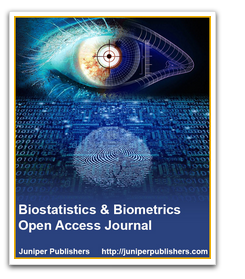Biostatistics and Biometrics - Juniper Publishers
Abstract
In this paper, we study the problem of testing the nullity of coefficients in restricted periodic exponential autoregressive model of order 1. We consider two cases: tests for the nullity of one coefficient and test of linearity this will be achieved by using the standard Wald test.
Keywords: Nonlinear time series, Restricted Periodic exponential autoregressive model, Least squares estimation, Wald test
Abbreviations: EXPAR: Exponential Autoregressive Models; PEXPAR: Periodic Exponential Autoregressive Models; LS: Least Squares; LSE: Least Squares Estimator
Introduction
Since the introduction of the exponential autoregressive models (EXPAR) by Ozaki [1] to capture some features of the non-linear vibration theory, several papers discussed their theoretical and practical aspects as ChanandTong [2], Al-KassamandLane [3]; Allal & El Melhaoui [4]; Ghosh, et al. [5]; Azouagh & El Melhaoui [6] and many others and when we have data exhibiting nonlinear behaviour such amplitude dependent frequency and periodic autocovariance structure, it will be suitable to use a periodic version of the EXPAR model. The notion of periodicity due to Gladyshev [7], was exploited to introduce the restricted periodic EXPAR(1) model (PEXPAR) in Merzougui et al. [8] and an optimal test of periodicity is given there, the parameters were estimated by the least squares (LS) method in Merzougui [8] and the test of Student was used for testing the nullity of the coefficients in the application but the problem of testing linearity has not been treated before.
Nonlinear time series models are generally more complex than linear ones so it is important first to do the linearity test before considering them. In our testing problems the parameter is not at the boundaries of stationarity so the solution is very standard, we choose the Wald test and we begin by testing the coefficients of the restricted PEXPAR(1) model as it is a novel model and then we approach the linearity test. The Wald statistic is defined in the usual way see for example Bierens [9]. It is given by a quadratic form based on the difference between the unrestricted estimated value of the restrictions and their value under the null hypothe sis. The paper is organized as follows. In section 2, we discuss the model and we remind the asymptotic normality of Least Squares Estimator (LSE) of the parameters and dene the Wald test for nullity of one coefficient which is based on the LSE. Section 3 provides a test for linearity after rearranging the parameters.
To Know more about Biostatistics and Biometrics
Click here: https://juniperpublishers.com/index.php





No comments:
Post a Comment